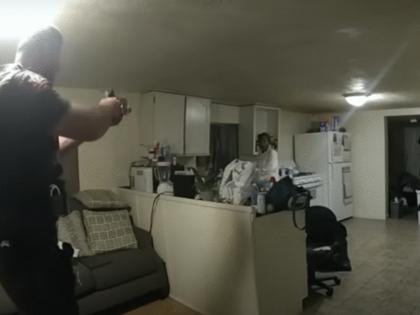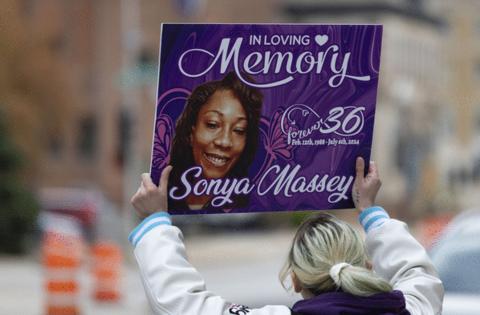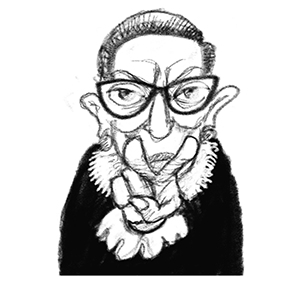Jury finds former Illinois sheriff's deputy guilty of second-degree murder in killing of Sonya Massey
Published in News & Features
SPRINGFIELD, Ill. — A jury found Sean Grayson, a former Sangamon County sheriff’s deputy, guilty of second-degree murder Wednesday in the killing last year of Sonya Massey inside her home near Springfield, a case that sparked national outrage and calls for police reforms.
The mostly white, 12-member jury in Peoria announced its verdict one week after testimony began in a case that focused on graphic police body camera footage of Grayson, who is white, fatally shooting Massey, a 36-year-old Black mother of two, after he repeatedly shouted at her to drop a pot of boiling water. It also centered on the prosecution’s accusations that Grayson, now 31, repeatedly failed to follow law enforcement policies or training, damaging testimony from Grayson’s partner that suggested Grayson didn’t do enough to help save Massey’s life after shooting her, and Grayson’s own testimony that shooting Massey was a way to “match” the level of her threatening actions.
The verdict is the culmination of an incident that spurred protests across the country that highlighted the treatment of Black citizens at the hands of law enforcement officers, including a statement from then-President Joe Biden, who said Massey’s death “reminds us that all too often Black Americans face fears for their safety in ways many of the rest of us do not.”
Demonstrations occurred outside the Peoria County Courthouse, some 75 miles from where Massey was killed on July 6, 2024, throughout much of the trial. It was moved from Sangamon County at the urging of Grayson’s lawyers, who argued their client couldn’t get a fair trial in Illinois’ capital city amid extensive news coverage of the killing.
The case also underscored law enforcement’s often-imperfect hiring practices, as Grayson had previously worked for five other law enforcement agencies and got hired by the Sangamon County sheriff’s office despite some previous employers criticizing his performance.
After Massey’s death, Gov. JB Pritzker approved a measure requiring local and state law enforcement agencies in Illinois to be more transparent about former officers’ work histories when they seek employment with another police force. A local commission was also established in Massey’s name for community leaders to examine certain issues, including societal inequalities in minority neighborhoods, in the Springfield area.
State Sen. Doris Turner, a Democrat from Springfield who worked on the legislation and pushed for the commission’s formation, said Wednesday’s verdict shows “no one is above the law.”
“I stand with the Massey family and my community as we continue to mourn the unjust loss of Sonya,” Turner said in a statement. “Since Sonya’s murder, I’ve been committed to — and will continue to — put in the work to make necessary changes to ensure our community has trust in those who have taken the oath to protect and serve.”
Grayson had also been charged with first-degree murder but the jury was allowed to consider convicting Grayson on second-degree murder, which is a lesser charge.
In Illinois, second-degree murder was previously called voluntary manslaughter. It requires jurors to find that the prosecutors have proven all the elements of first-degree murder. Then they must decide whether the defense has shown it is likely more true than not that Grayson believed he was justified in his actions, but that belief was unreasonable. Second-degree murder does not carry mandatory prison time, as defendants can be sentenced to four to 20 years in prison, or even receive probation.
At trial, during his opening remarks to the jury last week, Sangamon County State’s Attorney John Milhiser summarized much of what jurors and the public saw on the police body camera footage, including when Massey, who had been suffering from mental health challenges, uttered the words “please God” repeatedly when Grayson and his partner arrived at her home on the outskirts of Springfield. Milhiser explained to the jurors how they would see a “nice kind” of exchange between Massey and the deputies before “the defendant gets mad at a woman who is standing in her kitchen.”
Milhiser noted that while Grayson’s partner, Dawson Farley, immediately activated his body camera upon arrival at the scene, Grayson failed to turn on his camera until later — a pattern, Milhiser argued, that Grayson repeatedly did not follow law enforcement policies or training.
In his opening statement to the jury, which included one Black man, one of Grayson’s lawyers argued that someone would not reasonably think Grayson made up his mind to kill Massey when the officer went to her home. The lawyer, Daniel Fultz, also alluded to a point in the body camera footage when “she makes a comment along the lines of ‘don’t hurt me’ and Grayson responds, ‘why would we hurt you?’”
From there, Fultz said, the encounter quickly escalated into a situation in which Grayson needed to protect himself and his partner from the danger posed by the boiling water.
On Monday, Grayson was called to the witness stand by his lawyers after the prosecution rested its case. According to the Springfield State Journal-Register, the former deputy conceded he should have turned on his body camera earlier, when he and Farley arrived at Massey’s home. But Grayson said his concerns were raised soon after he arrived at Massey’s home, after he saw a car with a broken window in Massey’s driveway, and after she didn’t answer the door right away.
Inside the home, according to the body camera footage, Grayson asked Massey to see her identification, a request that appeared to annoy Massey as she sat on her couch. As she went through her purse and a bag, Massey said she couldn’t find her ID. She then got up and walked to her kitchen to grab a pot off her stove.
“Where you going?” she said to one of the deputies, to which Grayson replied lightheartedly in the video, “away from your hot, steaming water.”
“Oh, I’ll rebuke you in the name of Jesus,” Massey said a moment later.
In his testimony, Grayson said he took that comment as a threat and thought she was going to throw boiling water on him, the State-Journal Register reported. He also admitted that the only thing he had to “match” the level of Massey’s threat was his gun, according to the newspaper’s report of the testimony.
Last week, policing expert Seth Stoughton, a professor at the University of South Carolina Joseph F. Rice School of Law, testified that Grayson was “tactically unsound” in his response to Massey. Stoughton had also testified as an expert in the 2021 trial of Derek Chauvin, the ex-Minneapolis police officer convicted in the 2020 murder of George Floyd, saying Chauvin’s actions were unreasonable.
The Grayson trial jury viewed the body camera footage, which included Massey’s final moments and the aftermath. The footage showed Farley applying pressure to her wound with a towel to try to stop the bleeding. As the footage was shown, one juror appeared to look down while another had a look of disbelief. In the gallery, a couple of Massey’s loved ones left the courtroom, and a few others appeared to cry quietly.
In the video, Farley told Grayson moments after the shooting that he wanted to get his medical kit to try to stop Massey’s bleeding before paramedics arrived. Initially, Grayson discouraged him from rendering aid because she was “done.” Shortly thereafter, Farley was seen on video going to the kitchen to retrieve a towel to apply pressure to Massey’s wound.
In his testimony, Farley said, despite not being the officer who shot Massey, “if you use force on anyone, it’s your job to render aid.” Meanwhile, the video showed Grayson eventually retrieved his medical kit and when he asked one officer if there was “anything you think we can do for her,” and the officer said no, Grayson replied, “Alright, I’m not even going to waste my med stuff then.”
Nathaniel Patterson, a forensic pathologist for the Sangamon County coroner’s office, testified last week that Massey’s injury was potentially survivable but contingent on stopping the bleeding to give doctors a chance to save her.
_____
©2025 Chicago Tribune. Visit chicagotribune.com. Distributed by Tribune Content Agency, LLC.










Comments